Frequent RepairsRising Energy BillsInconsistent TemperaturesUnusual Sounds or OdorsAge of the SystemPoor Air QualityLack of Smart FeaturesFrequent CyclingEvaluating Your OptionsEnvironmental ImpactFinancial ConsiderationsConclusion A home should ideally feel well-maintained and provide the comfort of a good indoor climate. With the rise in temperatures, you need an effective air conditioning unit. The question is, though, how do homeowners Read more
Just the Tip
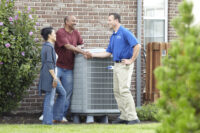
Table of Contents
A home should ideally feel well-maintained and provide the comfort of a good indoor climate. With the rise in temperatures, you need an effective air conditioning unit. The question is, though, how do homeowners know when it’s time to replace the AC? This guide offers unmistakable signs and tangible tips to determine whether or not you are ready for a new one.
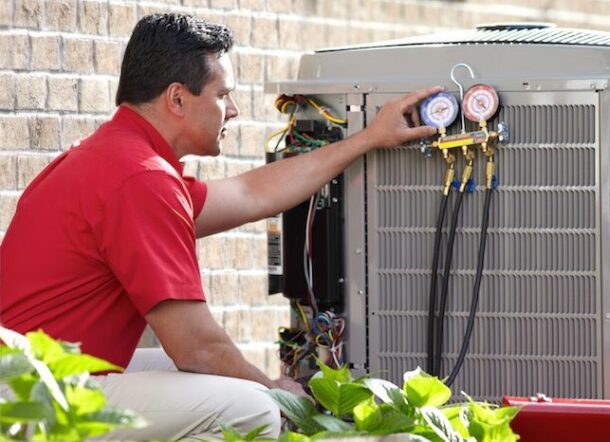
Frequent Repairs
One of the most apparent and common signs of a malfunctioning or outdated AC system is having to get it repaired continually. The investment cost is often better spent on a new system, especially if the unit is constantly needed and its repair costs are rising. Regular malfunctions not only make you uncomfortable, but they can also hurt your pocket heavily.
Rising Energy Bills
Increasing energy bills are a signal that your system may be inefficient. Older systems truly use more electric power to achieve the same level of cooling. Replacing it with a more efficient unit could mean less energy use and lower costs. Over time, you can check energy bills to see if the consistent rates or amounts indicate a change is in order. You can also do preventive maintenance with Professional Cincinnati Air Services.
Inconsistent Temperatures
If certain rooms feel warmer or cooler than others, the AC system may not be functioning optimally. Uneven cooling often indicates that the unit is struggling to distribute air evenly. This can be due to aging components or an improperly sized system. Upgrading could ensure consistent comfort throughout the home and help you set the right temperature.
Unusual Sounds or Odors
You don’t ignore plumbing tasks when you hear strange noises, right? In the same way, you should never ignore strange sounds or odors coming from an AC unit. Familiar sounds like grinding, squealing, or rattling usually signal a mechanical problem. A musty or burning smell could mean mold or an electrical issue. These can affect performance and be a safety issue, proving it’s time for a new system.
Age of the System
The average lifespan of an AC unit is between 10 and 15 years. If the system is nearing or past this range, an upgrade may be needed. Newer equipment is more efficient. Older systems are often not as efficient or technologically advanced as modern units, which means they may be less effective at cooling and cost more money due to excessive energy use.
Poor Air Quality
If an AC system has stopped being able to filter air well, it may mean poor-quality air in the house. Dust, allergens, and pollutants can circulate throughout the house, causing health issues. Installing a more recent system with advanced filtration can improve indoor air quality while making your home healthier.

Lack of Smart Features
Newer systems generally feature smart controls that can help them operate more efficiently. Such features include programmable thermostats, remote access, and tracking energy usage. When a system lacks these capabilities, upgrades can offer greater flexibility and control over the home’s temperature.
Frequent Cycling
If the AC unit cycles on and off frequently before the set temperature is reached, it may be short-cycling. This may cause wear and higher energy bills. Factors that may lead to short cycling include a defective thermostat and an oversized system. A new unit could fix these problems and work much more effectively.
Evaluating Your Options
Upgrading means several alternatives exist to choose from. Make sure to thoroughly research and compare different models based on energy efficiency and features that meet an individual’s or family’s particular needs. Specialists like Professional Cincinnati Air Services can also offer insight into the best options.
Environmental Impact
Many air-conditioning systems installed before 2010 use refrigerants that are bad for the environment. Today’s models use more environmentally friendly options, reducing greenhouse gas impact. This improvement is not just a gain for a home but also a step toward helping with environmental conservation.
Financial Considerations
The upfront price of a new air conditioning system may be substantial. However, with minimal repair service bills and reduced regular monthly power expenses, the investment will ultimately justify the cost. To help ease some of the financial strain, many manufacturers offer financing. So always think of the short-term and long-term financial impacts before an upgrade.
Conclusion
When deciding whether to upgrade the air conditioning system, it is necessary to consider the state of the current system, its age, and efficiency. By acknowledging the signs above, homeowners may use good judgment in their decisions, which leads to increased comfort and savings. For any home, upgrading to a modern, efficient system can keep homes cool and help create a healthier indoor environment, making it a wise investment.
HometownH2O collaboration upgrades Ohio family’s water access with comprehensive well transformation

Xylem, Waterboys initiative and Water Well Trust partner to ensure reliable water supply for local family An Ohio family once again has access to safe, reliable water, thanks to a collaborative effort between Xylem Inc., the Water Well Trust (WWT) and HometownH2O, a program of the Chris Long Foundation’s Waterboys initiative. As part of the Read more
Xylem, Waterboys initiative and Water Well Trust partner to ensure reliable water supply for local family
An Ohio family once again has access to safe, reliable water, thanks to a collaborative effort between Xylem Inc., the Water Well Trust (WWT) and HometownH2O, a program of the Chris Long Foundation’s Waterboys initiative. As part of the project, the family’s well underwent a complete overhaul, including donated equipment and drilling and installation services for a new well.
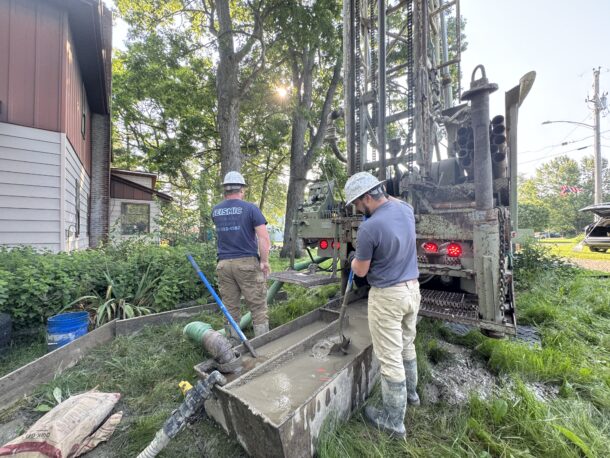
Andrew and Megan Olson, and their son, Declan Ward, have been living without a reliable water source for two years. Their well pump failed when the pump and the motor came apart and fell into the well. A local installer attempted to retrieve the pump but was not successful. Since then, the family has been contending with Megan’s muscular dystrophy (MD) diagnosis, and an unreliable water supply further exacerbated the situation.
Over the last two years, they have had to travel around to different friends’ homes to shower and do laundry on the weekends, which made it difficult to do much else. Outside of daily tasks, the family’s limited water supply prohibited them from many of the hobbies they routinely enjoyed, such as gardening, backyard bonfires and exercising.
“Everything in our daily lives was more difficult without water. I will feel so much better when we can finally turn the faucet back on, given our reality of floating around to different friends’ houses to take showers, cook food or do laundry,” said Meg Olson, Water Well Trust beneficiary. “It was such a relief to get the call from the Water Well Trust, knowing our family would soon have access to water in our own home.”
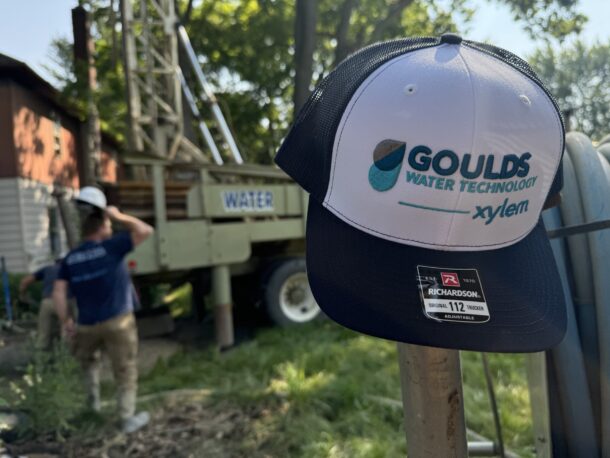
Along with a new well, project partners worked to build a wooden access ramp for Megan. They also provided other services, such as yard cleanup and installing a basketball hoop. Donations from local distributor Warren Pump & Supply Co., well driller and pump installer Seismic Drilling Co., as well as The Vinyl Institute, who donated PVC piping material, rounded out the project and were instrumental to its success.
“Hearing what the Olson family has gone through the past two years makes it meaningful to be a part of this incredible project that will ensure water security for years to come,” said Alex Rodriguez, market development manager at Xylem. “Our mission at Xylem is to find innovative solutions to make a water-secure world, so being able to support the positive change in the Olson family’s living situation is an honor.”
The Olson family’s well upgrade is the 22nd project for HometownH2O, a domestic water initiative dedicated to supplying clean water to families in need. Currently, more than 2.2 million Americans lack access to clean water, making this joint effort between Long, his Foundation’s Waterboys initiative, Xylem, and the Water Well Trust a vital resource for families across the country.
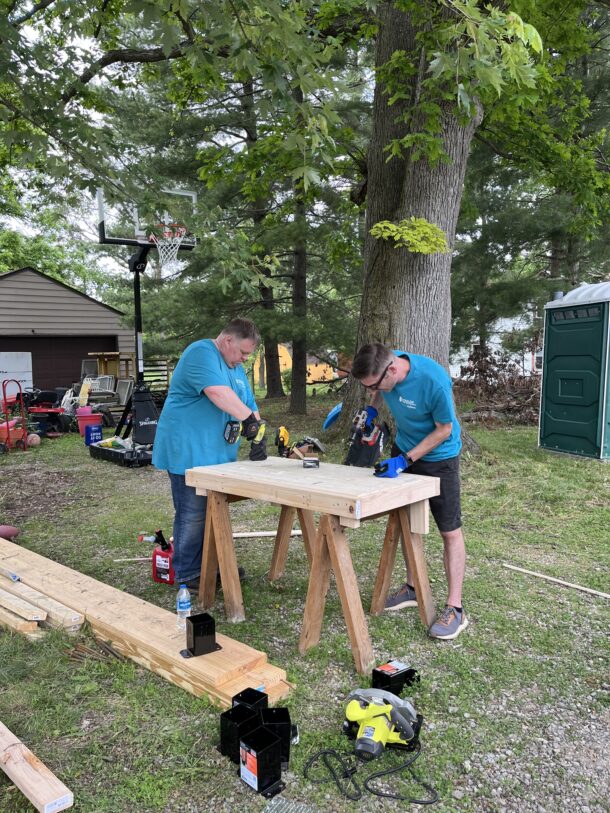
Xylem, in conjunction with its Goulds Water Technology brand, is engaged in regular water well initiatives to provide secure water access to rural areas, striving to increase public awareness of the challenges surrounding lack of water access. For more information about the Chris Long Foundation and HometownH2O projects, visit waterboys.org/hometown.
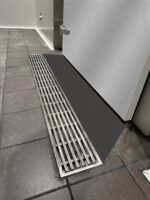
Ever walked into a commercial kitchen or industrial facility and noticed those long, narrow drains running along the floor? They’re not just there for looks—they’re trench drains, and when installed properly, they’re game changers for drainage performance and safety. For plumbers and project managers alike, trench drains are often overlooked until it’s too late. But Read more
Ever walked into a commercial kitchen or industrial facility and noticed those long, narrow drains running along the floor? They’re not just there for looks—they’re trench drains, and when installed properly, they’re game changers for drainage performance and safety.
For plumbers and project managers alike, trench drains are often overlooked until it’s too late. But when you consider the volume of water, debris, and grease that can accumulate in high-traffic commercial areas, it becomes clear – an efficient trench drain system isn’t a luxury, it’s a necessity.
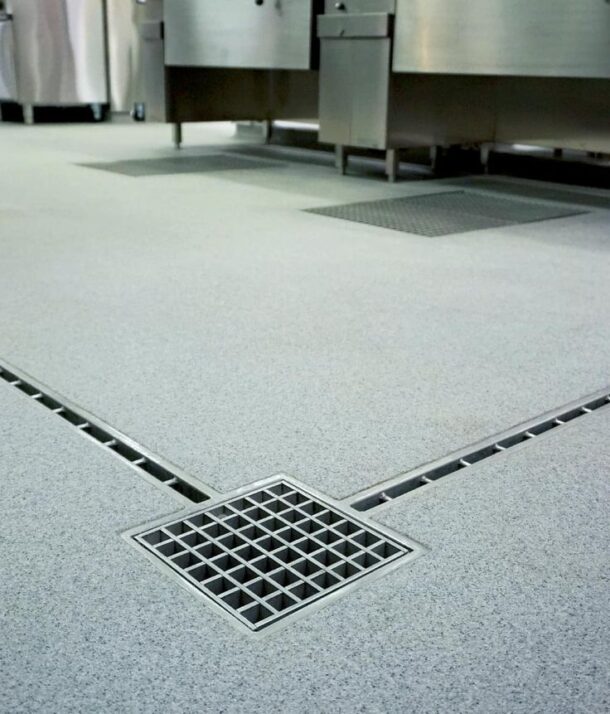
Why Trench Drains Matter in High-Use Environments
Commercial spaces like restaurants, breweries, warehouses, and car parks deal with far more runoff than residential properties. A basic point drain won’t cut it. Trench drains offer:
- Wide surface capture for rapid drainage
- Customisable grates to suit load ratings and slip resistance
- Durability under constant foot or vehicle traffic
They don’t just collect water, they control it. And in a commercial setting, that kind of control prevents costly downtime, water damage, or worse, a slip-and-fall injury.
Grate Selection and Slip Ratings: More Than Just Looks
Choosing the right grate isn’t just about strength—it’s also about safety. Grates come in a range of materials like stainless steel, ductile iron, galvanised steel, and plastic composites. The best option depends on your application. For example, stainless steel is corrosion-resistant and ideal for food-grade areas, while ductile iron handles heavy traffic with ease.
Slip resistance matters too. In Australia, AS 4586 governs slip resistance testing, while the U.S. refers to ANSI/NFSI B101.3. Look for grates that meet R11 or higher slip ratings in wet areas to reduce accident risk. Serrated surfaces, heel-proof slots, and even anti-slip coatings can enhance performance in greasy or moisture-prone environments.
Understanding Load Classes: AS 3996 vs. AASHTO M306
Load ratings help ensure your grate system won’t crack under pressure—literally. In Australia, AS 3996 outlines load classes from A (pedestrian use) to G (aircraft traffic). In the U.S., AASHTO M306 and EN 1433 provide similar guidance.
- Class A (AS): Light pedestrian use, garden paths, patios
- Class C (AS)/H-20 (US): Car parks, light vehicular traffic
- Class D–E (AS)/HS-25 (US): Industrial facilities, loading docks, emergency vehicle access
Always match the drain to the application. Misjudging load class is one of the most common and costly mistakes in trench drain installations.
Design Considerations: Flow Rate, Slope, and Materials
Planning a trench drain system requires more than just digging a channel. Are you working with forklifts or foot traffic? In food prep areas, hygiene and cleanability come first. For outdoor carparks, galvanised steel or polymer concrete channels are ideal for weather resistance.
And then there’s slope. A typical 1% grade (10mm per metre) allows water to flow efficiently, but higher volumes or debris-heavy areas may require a steeper gradient. The U.S. International Plumbing Code (IPC) and Australia’s AS/NZS 3500 both emphasise correct slope for sanitary and stormwater drainage.
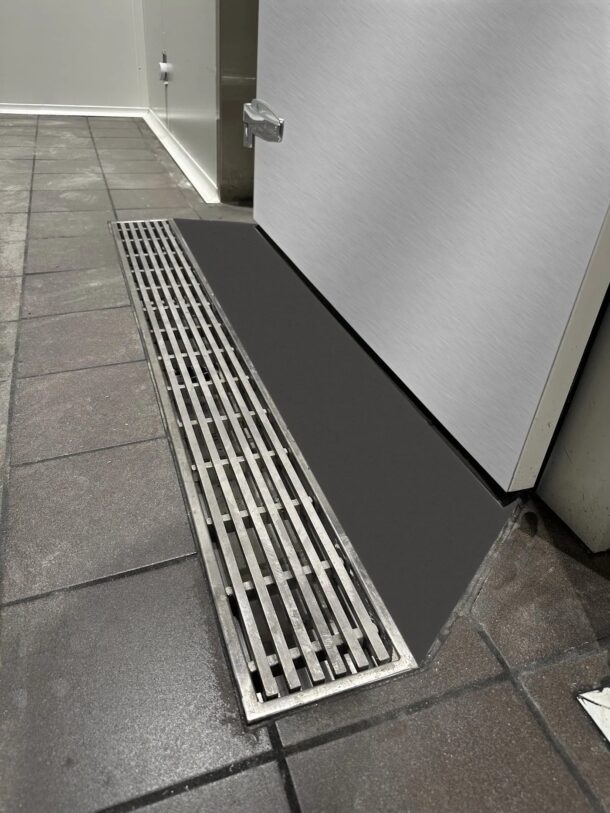
Installation Best Practices for Long-Term Performance
Installing trench drains isn’t complex, but it does demand precision. A few centimetres off-level can compromise the entire system. So how do you get it right?
- Plan for the outlet points before pouring concrete
- Use rebar or brackets to stabilise channels during the pour
- Ensure waterproof seals between each channel section
- Match trench depth and width to expected flow rates
Rushed installs and poor preparation often result in weak joins or incorrect elevations. And once the concrete sets, the fix isn’t easy or cheap.
Maintenance Matters: Keeping Drains Functional
Like any system, trench drains need upkeep. Food particles, sediment, or debris can build up quickly. Routine inspection and cleaning is critical, especially in kitchens or auto service bays where fats or oils can cause slow flow or blockages.
Use wet vacs, pressure cleaning, or enzyme-based drain cleaners depending on your environment. And make sure removable grates are regularly checked for corrosion, cracks, or warping.
Case Study: Drainage That Doesn’t Quit
We’ve seen our share of trench drain disasters, but we’ve also helped businesses turn things around. One recent project involved retrofitting a faulty drainage system in a Queensland car wash. Water used to pool around vacuum bays, causing rust and customer complaints. After assessing the layout, the team at Drain Masters Plumbing installed a sloped trench drain system with heavy-duty grates and dual outlets. Not only did the flooding stop, but the owners also saw a boost in online reviews almost immediately.
It’s proof that when drainage works, nobody notices. But when it doesn’t, everyone does.
Final Thoughts: Why Planning Ahead Pays Off
Trench drains might not be glamorous, but they’re critical infrastructure in any commercial plumbing system. The best time to think about drainage is before problems start—not after.
Whether you’re working on a new build or fixing someone else’s mistake, thoughtful trench drain design and installation can mean the difference between a seamless operation and a costly mess. So ask yourself: is your next project built to drain – or built to fail?

Jonathan Simon, Lubrizol Advanced Materials Inc. CPVC is one of the most widely used plumbing materials in the U.S. and has a number of advantages that make it ideal for residential plumbing. To follow are some tips for working with CPVC to ensure a fast, professional installation that stands the test of time. These tips Read more
Jonathan Simon, Lubrizol Advanced Materials Inc.
CPVC is one of the most widely used plumbing materials in the U.S. and has a number of advantages that make it ideal for residential plumbing. To follow are some tips for working with CPVC to ensure a fast, professional installation that stands the test of time. These tips are specific to Copper Tube Size CPVC (which is typically tan in color) and may not apply to IPS Schedule 80 CPVC (which is typically gray in color). As with any plumbing system, always consult the manufacturer’s instructions for specific handling and installation information.
Cutting and Welding Copper Tube Size CPVC
When installing CPVC, the pipe should be cut square, and any tailings and bevel on the pipe end removed by chamfering. Ratchet-style cutters can be used for new CPVC. For older CPVC pipe, a C-style tubing cutter, fine-tooth saw or wheel cutter is suggested as CPVC pipes become more rigid with age.
CPVC pipes and fittings are solvent welded together to create a bond that is the strongest part of the system. Copper Tube Size CPVC can use one-step solvent cement, such as FlowGuard® Gold 1-Step Yellow or new High Contrast Green Cement. The use of green solvent cement with CPVC was added to the 2024 codes of major bodies, including the Uniform Mechanical Code, Uniform Plumbing Code, International Plumbing Code, and International Mechanical Code.
Because service plumbers often need to make repairs quickly and get to the next job, a specially formulated solvent cement, Oatey® Orange Lava, was developed. It enables one-step cure times as fast as 15 minutes for cold water lines in certain conditions.
CPVC pipes and fittings use an interference fit to ensure a strong bond and it’s a good practice to test the fit before applying solvent cement. When you insert the pipe into the fitting, you should feel some resistance before bottoming out the pipe, which indicates a proper fit.
When applying cement, a good practice is to apply a heavy, even coat to the outside of the pipe end. Then, using the same applicator without additional cement, apply a thin coat inside the fitting socket. After the cement has been applied, the pipe should be inserted until it bottoms out against the fitting.
Always verify code requirements and follow the solvent cement manufacturer’s instructions for cure times and installation procedures.
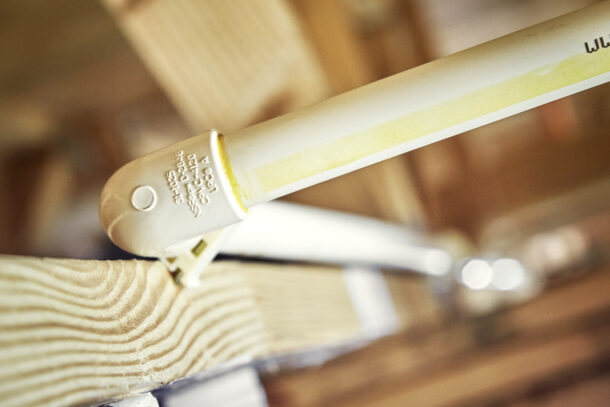
Avoiding Dry Fits
The friction between the pipe and fitting in a tight interference fit can hold for a long time at pressures above 100 psi without being solvent welded. That means if a joint in the system isn’t solvent welded, the system can still pass a pressure test. Over time, natural movement and stress on the system will cause an unwelded joint to fail. These dry-fit installation errors are extremely rare but can be very frustrating because the failure may occur after the building is occupied.
To avoid dry fits, never pre-assemble the system and then come back through with solvent cement. The best practice is to weld each joint as it is assembled. This also results in a faster installation. For added peace of mind, some contractors may require plumbers to initial joints with a after they are welded. Systems should still be visually inspected and High Contrast Green Solvent Cement makes this quality assurance process easier than ever.
Protecting CPVC pipes
Because CPVC resists degradation from chlorine, chloramines and chlorine dioxide in drinking water, using CPVC eliminates a key factor – incompatibility with local water conditions – that can shorten the life of other plumbing systems. Here are three things you can do to ensure a long life for CPVC pipes and fittings:
- Accommodate expansion and contraction: FlowGuard Gold CPVC can expand about 1 inch per 50 feet of straight length of pipe per 50°F temperature increase. In many cases, normal changes of direction can be enough to account for expansion and contraction provided the natural movement of the pipe is not restricted and there is adequate spacing between elbows and hangers. Overtightening pipe hangers may also restrict lateral movement of the pipe. For long, straight runs, loops or offsets can be used. Consult the manufacturer’s installation guidelines for instructions.
- Check for chemical incompatibility: If properly installed CPVC pipe experiences a failure, one possible culprit is contact with incompatible chemicals. The FBC™ System Compatible Program can be used to identify materials that are compatible and incompatible with FlowGuard Gold, BlazeMaster and Corzan CPVC. For other brands of CPVC piping, consult with the specific manufacturer(s) for compatibility information.
- Protect against freezing: There is no such thing as a freeze-proof pipe. All residential plumbing materials will fail if ice forms in the pipe, blocking water flow and creating pressures that exceed the material’s burst pressure. Always plan for cold weather – even in areas where it is uncommon – and follow best practices for protecting against freezing including those recommended by the pipe manufacturer.
Showcase Your Craftmanship
Professional plumbers appreciate CPVC because it is easy to work with and results in a clean, professional installation that highlights the plumber’s craftmanship and commitment to quality. Builders and homeowners appreciate CPVC because it can handle aggressive water conditions that can cause premature failure in other residential plumbing systems. For more information, visit flowguardgold.com.
These tips are for informational purposes only and do not replace any manufacturer’s instructions for handling or installing pipe.
Jonathan Simon is the North American residential plumbing manager for Lubrizol Advanced Materials Inc., the parent company for FlowGuard Gold Pipe and Fittings.

The best way to clear grease, sand and debris from a clogged drain is not with a drain snake. Water jetters are ideal for clearing soft stoppages and ice from clogged drain lines and sewer lines. They use a stream of high-pressure water that hits the stoppage and flushes it away. The thrust of the Read more
The best way to clear grease, sand and debris from a clogged drain is not with a drain snake. Water jetters are ideal for clearing soft stoppages and ice from clogged drain lines and sewer lines. They use a stream of high-pressure water that hits the stoppage and flushes it away. The thrust of the nozzle drives the hose down the line and gives you wall-to-wall cleaning action.
You don’t always need a heavy water jetter to clear a clogged drain.
General’s JM-1000 Mini-Jet brings surprising cleaning power to the job. You can be blasting away with this lightweight powerhouse before you could get your big machine off the truck.
The compact JM-1000 Mini-Jet gives you 1,500 psi of cleaning power, yet weighs just 23 lbs. Clear grease, sand, and debris from 1-1/2″ to 3″ lines. The pump and motor assembly are safely contained in a rugged metal diamond plate case that can handle abuse in the field. The portable package takes little space in your truck – It’s only 24″ x 10-1/2″ x 11″.
Vibration helps the hose slide around tight bends and reach farther down the line. This is what separates General’s Jet-Set from ordinary pressure washers. It breaks the initial tension between the surface of the hose and the walls of the pipe, increasing cleaning power.
The JM-1000 Mini-Jet generates 1,500 psi at 1.4 gpm yet pulls only 13 amps. The pump and motor are enclosed in a diamond plate metal housing and protected by a Ground Fault Circuit Interrupter.
A Water Sensor detects the moving water and automatically shuts off the motor if water isn’t flowing through the pump to protect the unit from damage.

The Mini-Jet includes Super-Flex™ high-pressure jet hose, a 4 pc. nozzle set including General’s unique Spring Leader nozzle, a water supply hose with a shut-off valve, and a threaded faucet adapter.
It is also available with an optional high-performance 3/16″ stainless steel braid hose with Teflon core for better cleaning power. General’s tough stainless steel braid hose design smoothly slides the jet nozzle down 1-1/2″ to 3″ drain lines – and more easily navigates tight bends. The 3/16″ Teflon core also reduces flow resistance, further improving small-line cleaning power.
